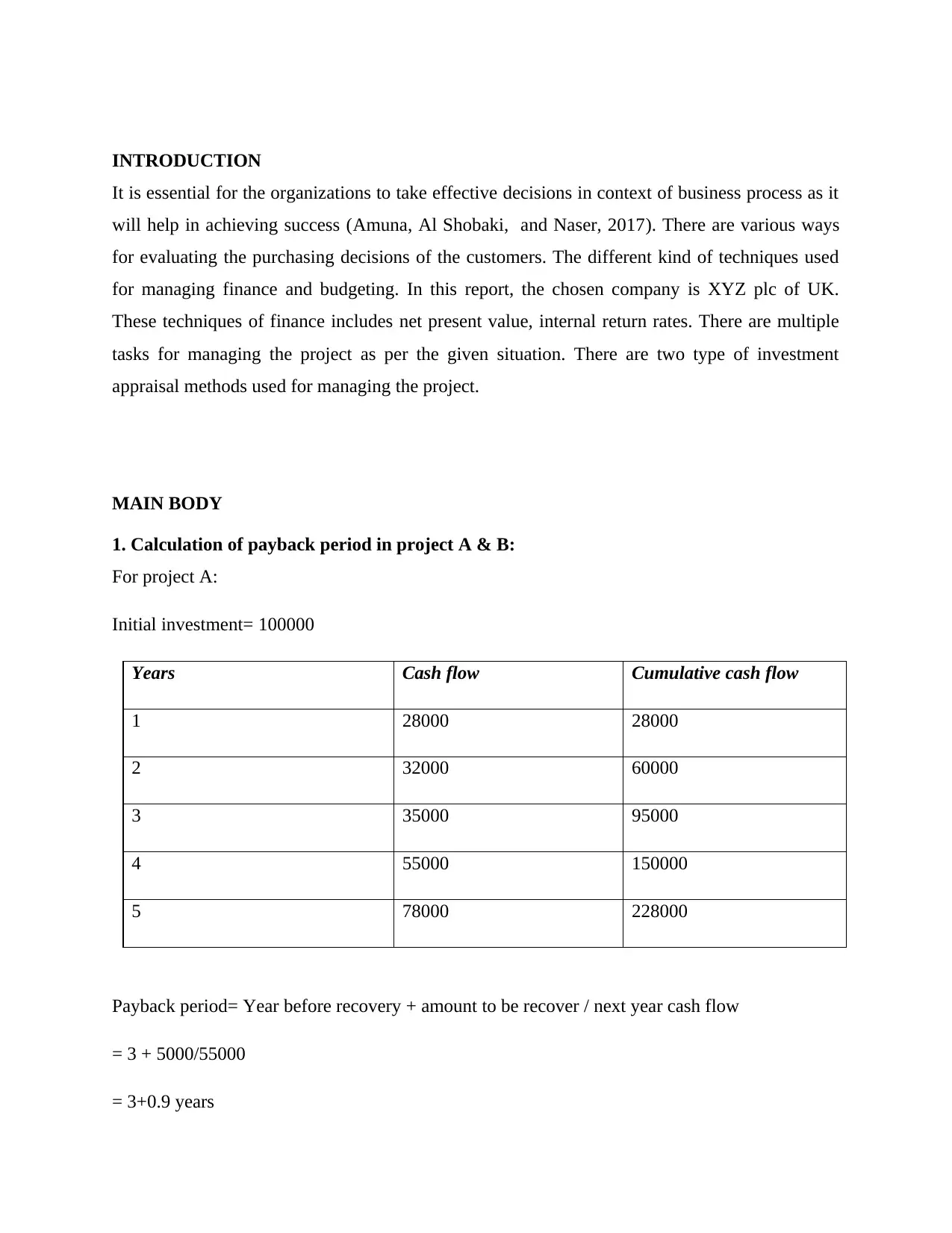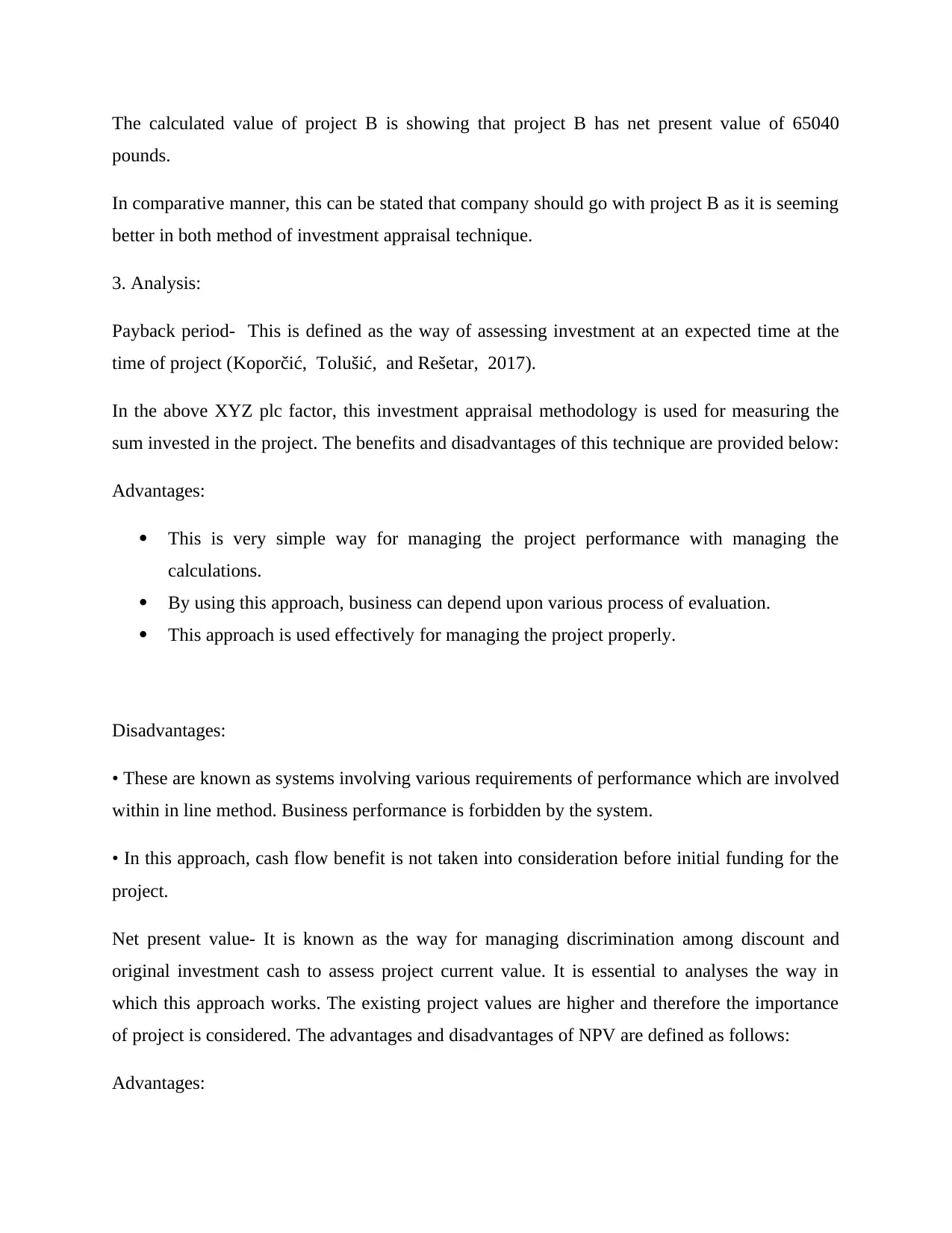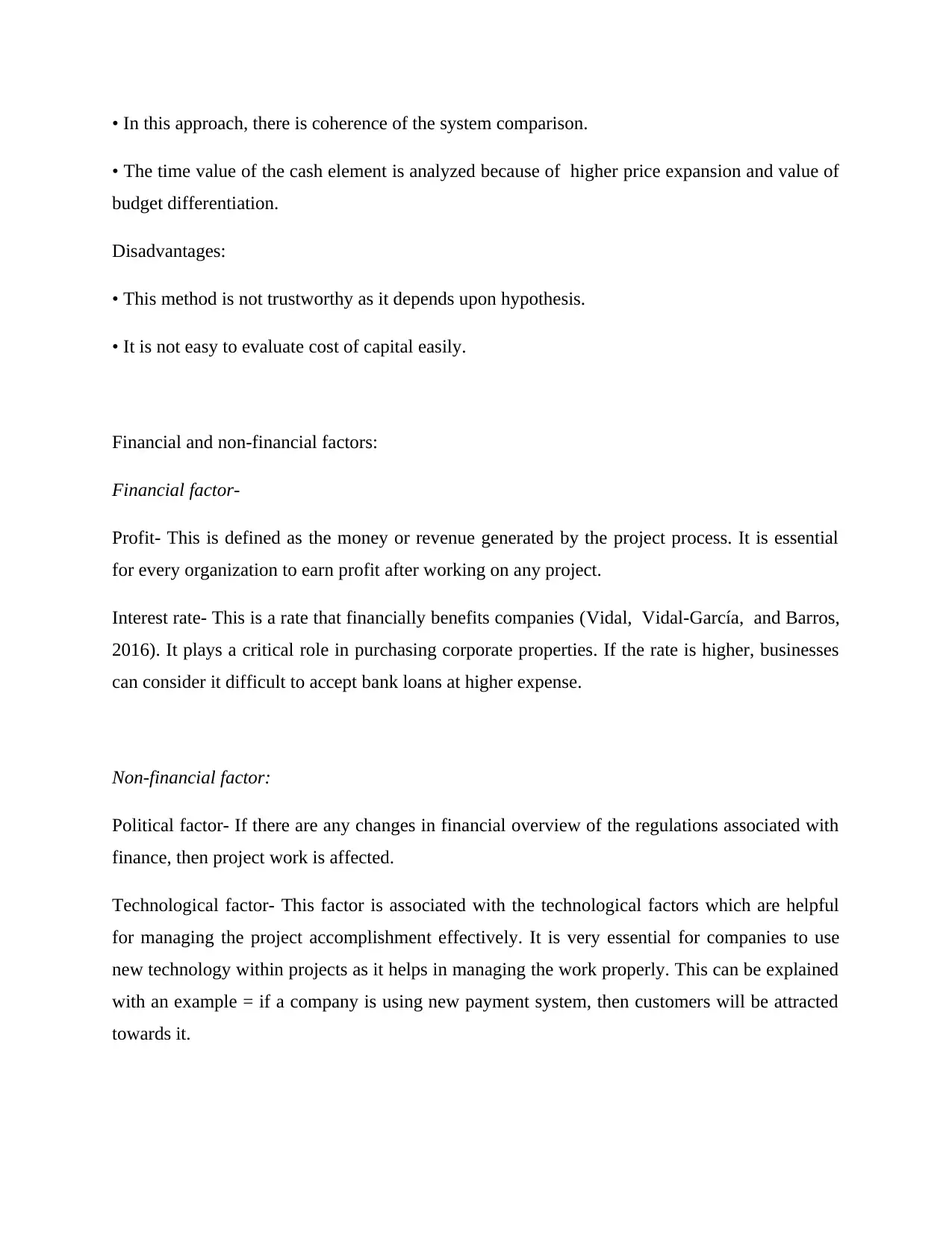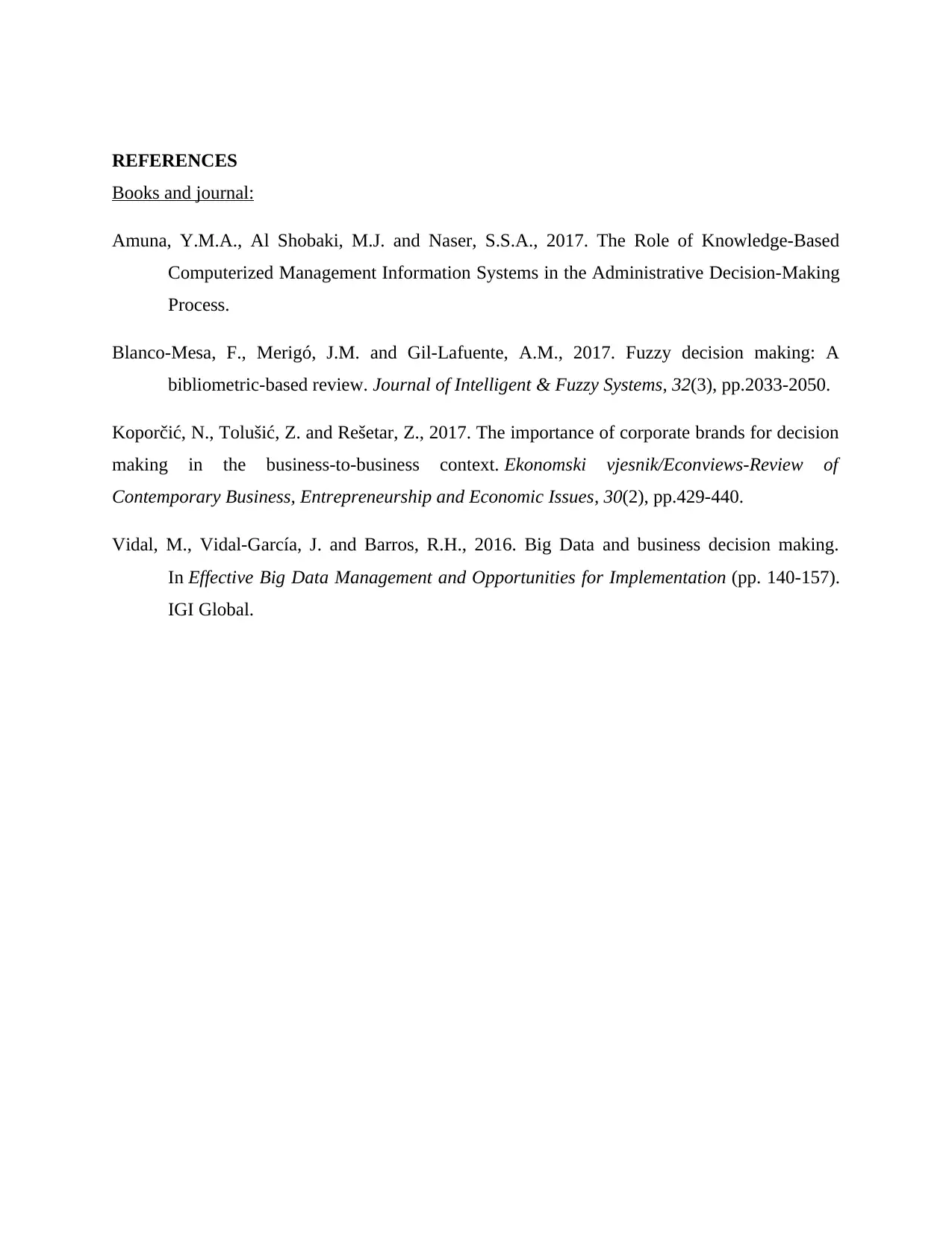Business Decision Report: Project Evaluation and Investment Appraisal
VerifiedAdded on 2023/01/11
|9
|1165
|39
Report
AI Summary
This report analyzes business decision-making processes, focusing on investment appraisal techniques such as payback period and Net Present Value (NPV). The report uses a case study of XYZ plc to evaluate two projects, A and B. It calculates and compares the payback periods and NPVs of both projects to determine which investment is more favorable. The report also discusses the advantages and disadvantages of each method, along with financial and non-financial factors influencing the decision. It concludes that based on the analysis, XYZ Limited should invest in Project B. The report provides a comprehensive overview of financial decision-making in a business context.

BUSINESS DECISION
MAKING
MAKING
Paraphrase This Document
Need a fresh take? Get an instant paraphrase of this document with our AI Paraphraser

Contents
INTRODUCTION.......................................................................................................................................3
MAIN BODY..............................................................................................................................................3
1. Calculation of payback period in project A & B:.................................................................................3
2. Calculation of NPV:............................................................................................................................5
CONCLUSION...........................................................................................................................................8
REFERENCES............................................................................................................................................9
INTRODUCTION.......................................................................................................................................3
MAIN BODY..............................................................................................................................................3
1. Calculation of payback period in project A & B:.................................................................................3
2. Calculation of NPV:............................................................................................................................5
CONCLUSION...........................................................................................................................................8
REFERENCES............................................................................................................................................9

INTRODUCTION
It is essential for the organizations to take effective decisions in context of business process as it
will help in achieving success (Amuna, Al Shobaki, and Naser, 2017). There are various ways
for evaluating the purchasing decisions of the customers. The different kind of techniques used
for managing finance and budgeting. In this report, the chosen company is XYZ plc of UK.
These techniques of finance includes net present value, internal return rates. There are multiple
tasks for managing the project as per the given situation. There are two type of investment
appraisal methods used for managing the project.
MAIN BODY
1. Calculation of payback period in project A & B:
For project A:
Initial investment= 100000
Years Cash flow Cumulative cash flow
1 28000 28000
2 32000 60000
3 35000 95000
4 55000 150000
5 78000 228000
Payback period= Year before recovery + amount to be recover / next year cash flow
= 3 + 5000/55000
= 3+0.9 years
It is essential for the organizations to take effective decisions in context of business process as it
will help in achieving success (Amuna, Al Shobaki, and Naser, 2017). There are various ways
for evaluating the purchasing decisions of the customers. The different kind of techniques used
for managing finance and budgeting. In this report, the chosen company is XYZ plc of UK.
These techniques of finance includes net present value, internal return rates. There are multiple
tasks for managing the project as per the given situation. There are two type of investment
appraisal methods used for managing the project.
MAIN BODY
1. Calculation of payback period in project A & B:
For project A:
Initial investment= 100000
Years Cash flow Cumulative cash flow
1 28000 28000
2 32000 60000
3 35000 95000
4 55000 150000
5 78000 228000
Payback period= Year before recovery + amount to be recover / next year cash flow
= 3 + 5000/55000
= 3+0.9 years
⊘ This is a preview!⊘
Do you want full access?
Subscribe today to unlock all pages.

Trusted by 1+ million students worldwide

The calculation is indicating that cost of this project A will be recovered in 3.09 years.
For project B:
Initial investment= 120000
Years Cash flow Cumulative cash flow
1 31000 31000
2 38000 69000
3 43000 112000
4 64000 176000
5 89000 265000
Payback period= 3+8000/64000
= 3+0.125
The above done calculation is showing that cost of project B will be covered in 3.12 years.
In accordance of calculation of payback period of both project A and B this can be stated that
company should go with project A as it will take less amount of time to recover cost of project
(Blanco-Mesa, Merigó, and Gil-Lafuente, 2017).
For project B:
Initial investment= 120000
Years Cash flow Cumulative cash flow
1 31000 31000
2 38000 69000
3 43000 112000
4 64000 176000
5 89000 265000
Payback period= 3+8000/64000
= 3+0.125
The above done calculation is showing that cost of project B will be covered in 3.12 years.
In accordance of calculation of payback period of both project A and B this can be stated that
company should go with project A as it will take less amount of time to recover cost of project
(Blanco-Mesa, Merigó, and Gil-Lafuente, 2017).
Paraphrase This Document
Need a fresh take? Get an instant paraphrase of this document with our AI Paraphraser

2. Calculation of NPV:
Project A:
NPV= Discounted cash flow – initial investment
Year
Cash
flow
PV
factor
Discounted cash
flow
1 28000 0.9 25200
2 32000 0.811 25952
3 35000 0.731 25585
4 55000 0.658 36190
5 78000 0.593 46254
159181
NPV= 159181-100000
= 59181
The above done calculation is showing that project A has net present value of 59181 pounds.
Project B:
Year
Cash
flow
PV
factor
Discounted cash
flow
1 31000 0.9 27900
2 38000 0.811 30818
3 43000 0.731 31433
4 64000 0.658 42112
5 89000 0.593 52777
185040
NPV= 185040-120000
= 65040
Project A:
NPV= Discounted cash flow – initial investment
Year
Cash
flow
PV
factor
Discounted cash
flow
1 28000 0.9 25200
2 32000 0.811 25952
3 35000 0.731 25585
4 55000 0.658 36190
5 78000 0.593 46254
159181
NPV= 159181-100000
= 59181
The above done calculation is showing that project A has net present value of 59181 pounds.
Project B:
Year
Cash
flow
PV
factor
Discounted cash
flow
1 31000 0.9 27900
2 38000 0.811 30818
3 43000 0.731 31433
4 64000 0.658 42112
5 89000 0.593 52777
185040
NPV= 185040-120000
= 65040

The calculated value of project B is showing that project B has net present value of 65040
pounds.
In comparative manner, this can be stated that company should go with project B as it is seeming
better in both method of investment appraisal technique.
3. Analysis:
Payback period- This is defined as the way of assessing investment at an expected time at the
time of project (Koporčić, Tolušić, and Rešetar, 2017).
In the above XYZ plc factor, this investment appraisal methodology is used for measuring the
sum invested in the project. The benefits and disadvantages of this technique are provided below:
Advantages:
This is very simple way for managing the project performance with managing the
calculations.
By using this approach, business can depend upon various process of evaluation.
This approach is used effectively for managing the project properly.
Disadvantages:
• These are known as systems involving various requirements of performance which are involved
within in line method. Business performance is forbidden by the system.
• In this approach, cash flow benefit is not taken into consideration before initial funding for the
project.
Net present value- It is known as the way for managing discrimination among discount and
original investment cash to assess project current value. It is essential to analyses the way in
which this approach works. The existing project values are higher and therefore the importance
of project is considered. The advantages and disadvantages of NPV are defined as follows:
Advantages:
pounds.
In comparative manner, this can be stated that company should go with project B as it is seeming
better in both method of investment appraisal technique.
3. Analysis:
Payback period- This is defined as the way of assessing investment at an expected time at the
time of project (Koporčić, Tolušić, and Rešetar, 2017).
In the above XYZ plc factor, this investment appraisal methodology is used for measuring the
sum invested in the project. The benefits and disadvantages of this technique are provided below:
Advantages:
This is very simple way for managing the project performance with managing the
calculations.
By using this approach, business can depend upon various process of evaluation.
This approach is used effectively for managing the project properly.
Disadvantages:
• These are known as systems involving various requirements of performance which are involved
within in line method. Business performance is forbidden by the system.
• In this approach, cash flow benefit is not taken into consideration before initial funding for the
project.
Net present value- It is known as the way for managing discrimination among discount and
original investment cash to assess project current value. It is essential to analyses the way in
which this approach works. The existing project values are higher and therefore the importance
of project is considered. The advantages and disadvantages of NPV are defined as follows:
Advantages:
⊘ This is a preview!⊘
Do you want full access?
Subscribe today to unlock all pages.

Trusted by 1+ million students worldwide

• In this approach, there is coherence of the system comparison.
• The time value of the cash element is analyzed because of higher price expansion and value of
budget differentiation.
Disadvantages:
• This method is not trustworthy as it depends upon hypothesis.
• It is not easy to evaluate cost of capital easily.
Financial and non-financial factors:
Financial factor-
Profit- This is defined as the money or revenue generated by the project process. It is essential
for every organization to earn profit after working on any project.
Interest rate- This is a rate that financially benefits companies (Vidal, Vidal-García, and Barros,
2016). It plays a critical role in purchasing corporate properties. If the rate is higher, businesses
can consider it difficult to accept bank loans at higher expense.
Non-financial factor:
Political factor- If there are any changes in financial overview of the regulations associated with
finance, then project work is affected.
Technological factor- This factor is associated with the technological factors which are helpful
for managing the project accomplishment effectively. It is very essential for companies to use
new technology within projects as it helps in managing the work properly. This can be explained
with an example = if a company is using new payment system, then customers will be attracted
towards it.
• The time value of the cash element is analyzed because of higher price expansion and value of
budget differentiation.
Disadvantages:
• This method is not trustworthy as it depends upon hypothesis.
• It is not easy to evaluate cost of capital easily.
Financial and non-financial factors:
Financial factor-
Profit- This is defined as the money or revenue generated by the project process. It is essential
for every organization to earn profit after working on any project.
Interest rate- This is a rate that financially benefits companies (Vidal, Vidal-García, and Barros,
2016). It plays a critical role in purchasing corporate properties. If the rate is higher, businesses
can consider it difficult to accept bank loans at higher expense.
Non-financial factor:
Political factor- If there are any changes in financial overview of the regulations associated with
finance, then project work is affected.
Technological factor- This factor is associated with the technological factors which are helpful
for managing the project accomplishment effectively. It is very essential for companies to use
new technology within projects as it helps in managing the work properly. This can be explained
with an example = if a company is using new payment system, then customers will be attracted
towards it.
Paraphrase This Document
Need a fresh take? Get an instant paraphrase of this document with our AI Paraphraser

CONCLUSION
From the above mentioned report, it is discussed that financial reviews are done in proper
manner for managing the alternative of investment. In this, there is evaluation of two projects A
and B in which payback process and NPV strategies are developed. From the above analysis, it is
concluded that XYZ Limited will invest in Project B.
From the above mentioned report, it is discussed that financial reviews are done in proper
manner for managing the alternative of investment. In this, there is evaluation of two projects A
and B in which payback process and NPV strategies are developed. From the above analysis, it is
concluded that XYZ Limited will invest in Project B.

REFERENCES
Books and journal:
Amuna, Y.M.A., Al Shobaki, M.J. and Naser, S.S.A., 2017. The Role of Knowledge-Based
Computerized Management Information Systems in the Administrative Decision-Making
Process.
Blanco-Mesa, F., Merigó, J.M. and Gil-Lafuente, A.M., 2017. Fuzzy decision making: A
bibliometric-based review. Journal of Intelligent & Fuzzy Systems, 32(3), pp.2033-2050.
Koporčić, N., Tolušić, Z. and Rešetar, Z., 2017. The importance of corporate brands for decision
making in the business-to-business context. Ekonomski vjesnik/Econviews-Review of
Contemporary Business, Entrepreneurship and Economic Issues, 30(2), pp.429-440.
Vidal, M., Vidal-García, J. and Barros, R.H., 2016. Big Data and business decision making.
In Effective Big Data Management and Opportunities for Implementation (pp. 140-157).
IGI Global.
Books and journal:
Amuna, Y.M.A., Al Shobaki, M.J. and Naser, S.S.A., 2017. The Role of Knowledge-Based
Computerized Management Information Systems in the Administrative Decision-Making
Process.
Blanco-Mesa, F., Merigó, J.M. and Gil-Lafuente, A.M., 2017. Fuzzy decision making: A
bibliometric-based review. Journal of Intelligent & Fuzzy Systems, 32(3), pp.2033-2050.
Koporčić, N., Tolušić, Z. and Rešetar, Z., 2017. The importance of corporate brands for decision
making in the business-to-business context. Ekonomski vjesnik/Econviews-Review of
Contemporary Business, Entrepreneurship and Economic Issues, 30(2), pp.429-440.
Vidal, M., Vidal-García, J. and Barros, R.H., 2016. Big Data and business decision making.
In Effective Big Data Management and Opportunities for Implementation (pp. 140-157).
IGI Global.
⊘ This is a preview!⊘
Do you want full access?
Subscribe today to unlock all pages.

Trusted by 1+ million students worldwide
1 out of 9
Related Documents
Your All-in-One AI-Powered Toolkit for Academic Success.
+13062052269
info@desklib.com
Available 24*7 on WhatsApp / Email
![[object Object]](/_next/static/media/star-bottom.7253800d.svg)
Unlock your academic potential
Copyright © 2020–2025 A2Z Services. All Rights Reserved. Developed and managed by ZUCOL.





